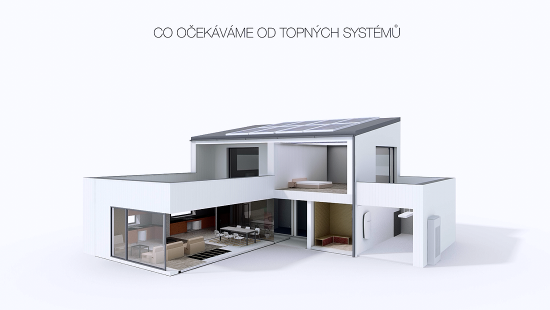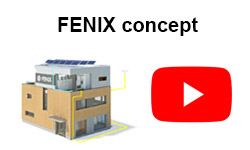Nearly zero-energy houses – the future is electric
A new opportunity for electric heating systems in the era of Nearly Zero-Energy Building construction – EPBD 2020 nZEB. A new concept for a new era!

- Thermal losses from buildings and so also energy consumption have significantly declined and thus in many cases operating costs have ceased to be a decisive issue. Other factors have become more important: the size of the initial investment, maintenance and inspection costs, autonomy, lifespan, the reliability of the system and the comfort level provided.
- In the 2013–2014 season Fenix collaborated with the Czech Technical University in Prague and UCEEB in the measurement and evaluation of three such buildings. One of the conclusions was the fact that in these buildings, electric decentralized systems are 20–25% more effective than warm water systems thanks to their high flexibility.
- In addition, over the last two years we have been carrying out relatively extensive experiments with roof-mounted photovoltaic systems, alternative water heating methods, etc. In this way we have gained a whole range of very relevant findings. Another, completely new challenge is the commencement of the building of new structures “with nearly zero energy consumption” from 2020.
- Again in cooperation with the Czech Technical University in Prague and UCEEB, and under the technical auspices of the Ministry of Industry and Trade, the Ministry of the Environment and the Energy Regulatory Office, we are preparing a project for the construction of such a house this year in Jeseník. The house will be fitted with electric radiant heating, a roof-mounted photovoltaic system and domestic batteries for the storage of surplus power and to ensure equal energy consumption throughout the building. The structure will also be prepared for cooperation with the “smart grid” so that the batteries can be charged not only from the solar panels but also at set times from the electricity grid, while at other set times a signal will limit or stop the drawing of electricity from the public network.
Why an electric radiant heating system?
- Such systems are highly flexible, quickly and automatically reacting to supplementary heat gains in individual parts of a home.
- Widespread warm water systems (with whatever source, including heat pumps) are not capable of providing such flexibility and precision in the delivery of a small amount of needed heat to various regions within a building. Attempts at more precise control generate excessive costs.
- Electric radiant systems provide heat primarily via radiation, which is the most efficient method of heat transfer (with the exclusion of air as a heat carrier).
- All living organisms are genetically equipped for the absorption of radiant heat (from the sun or from fire). This gives radiant systems a fundamental advantage over another competitor, warm air heating systems. In their case the radiant component is zero, meaning that the organism doesn't have such a positive and fully-satisfied feeling from their use.
- The construction of houses with almost zero energy consumption will also require a share of the energy to be produced from the house's own renewable sources. The current amendment to the Energy Act provides for the roof installation of solar PV systems with an output of up to 10 kWp, which should be sufficient to cover the majority of the energy requirements of a house equipped by our heating systems.
- Progress in the area of energy storage with the aid of domestic batteries, and their growing affordability, is bringing about a fundamental shift in attitudes to the electric heating of buildings.
- The use of electric radiant heating systems with perfect thermal regulation has become very economically attractive from the perspective of acquisition costs, maintenance costs and system lifespan. Acquisition costs are falling relative to installed output while maintenance costs are close to zero and the lifespan of such systems is 40 years, and this is all for a completely autonomous system that can be checked remotely, etc.
- The existing penalization of electrical energy via the so-called NPE coefficient is going to decrease rapidly with regard to the move to emission-free and renewable sources. One significant factor will be the huge potential in the regulation of energy systems via the storage of momentary energy surpluses from unstable renewable sources in domestic batteries. Electric heating will thus become fully integrated into the "smart grids" concept.
The Fenix Office Centre - a building constructed to the 2020 standard
| Commencement | 10/2015 |
| Completion | 05/2016 |
| Total consumption | 27 830 kWh |
| PV | 8.5 kWp |
| Annual production | 8 400 kWh |
| Home battery | 30 kWh |
- Cooperation between photovoltaic system, domestic battery and smart grid.
- Construction of the object will take place under the technical supervision of the Czech Technical University in Prague – Department of TZB, which will simultaneously monitor and evaluate the structure.
- The following central administrative bodies sent their experts to the working groups:
- The Ministry of Industry and Trade
- The Ministry of the Environment
- The Energy Regulatory Office
- The Chairman of the Board of Directors of ČEPS (the only Transmission System Operator in the Czech Republic) has also expressed interest in information from the project.
- The aim of the project is to evaluate cooperation between a solar PV system with domestic batteries and the “smart grid” in order to prove the advantageousness of this solution for operators of energy systems and for consumers, and to create the conditions for the determination of a new tariff for buildings with domestic batteries. During periods with surplus energy, such batteries will draw energy from the network under favorable pricing conditions, while during peak periods they will provide the building with total or partial energy autonomy. Significantly higher energy independence and a marked decrease in energy vulnerability will be achieved at the same time.







